Are you passionate about health and wellness? Do you want to share your knowledge and experience with others by writing about it?
If yes, then you should start a health & wellness blog.
There is a lot of money to be made in the wellness industry, and starting a health and wellness blog is a great way to get involved.
This post will teach you exactly how to start a health and wellness blog and make money online.
So whether you’re looking to make some extra cash or you are interested in making blogging about health & wellness into a full-time career, this guide will help you with everything you need to know to start a wellness blog.
So let us jump right in and start health blogging.

How to Start a Health & Wellness Blog in 7 Steps
- Define Your Health & Wellness Blogging Goals
- Choose a Health & Wellness Niche
- Pick & Register a Blog Domain Name
- Setup WordPress
- Write & Publish Blog Posts
- Promote Your Health & Wellness Blog
- Monetize & Make Money
1. Define Your Health & Wellness Blogging Goals
To start a successful health & wellness blog, it’s important to define your goals.
Some common goals for health and wellness bloggers include:
- becoming an industry expert or thought leader in the health & wellness space
- building a community of readers and followers who are passionate about their health and well-being
- making money through advertising, affiliate marketing, or other forms of monetization
Once you have defined your goals, you can take steps to achieve them by publishing high-quality content regularly.
What is a Health & Wellness Blog?
A health & wellness blog is a platform for bloggers to share personal experiences, opinions, and knowledge about health and wellness topics such as nutrition, fitness, mental health, and more.
Why Start a Health & Wellness Blog?
There are many reasons to start a health & wellness blog. Some of the benefits of starting a health & wellness blog include:
- Become an influencer in the health and wellness space
- Build a community of like-minded health enthusiasts.
- Help others by sharing your knowledge and experience
- Network with other health & wellness influencers
- Make money online by blogging about health and wellness.
No matter what your goals are for starting a health & wellness blog, there are plenty of opportunities to be successful if you have the right approach.
How much money can you make from health & wellness blogging?
You can make $15-$25 for every 1000 ad views on your health & wellness blog. An SEO optimized blog post can get anywhere between 300 to 1000 visits per month. So, a health & wellness blog with 100 blog posts can make as high as $2500 every month. You can make even more money if you monetize with affiliate marketing and digital products.
2. Choose a Health & Wellness Niche
Once you have set your goals and defined your blog, the next step is to choose a niche.
A niche refers to the topic or area of focus that you want your blog to cover.
There are many different health and wellness niches to choose from, including nutrition, fitness, mental health, beauty & skincare, and more.
Why choose a niche?
Choosing a niche allows you to focus your content and build an audience of people who are interested in that specific topic.
It also makes it easier to monetize your blog because you can target ads and affiliate products that are relevant to your niche audience.
If you blog about everything related to health and wellness, you will have a hard time attracting an audience who is interested in everything you talk about. This will limit your blog’s growth.
Finding Your Ideal Niche
There are a few different ways to find the perfect niche for your health & wellness blog.
One way is to start by brainstorming potential topics that you are interested in or passionate about. It also helps to have knowledge or experience in the niche that you focus on.
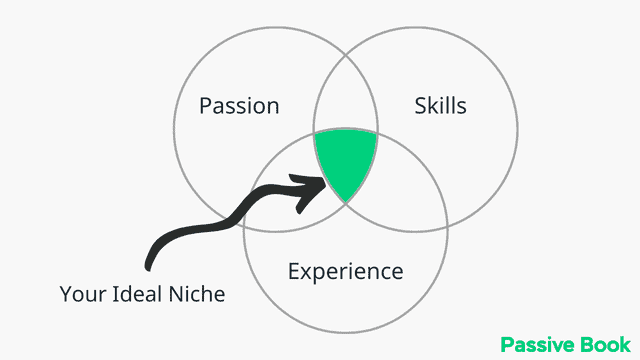
You can also look at how other successful health & wellness bloggers have built their audiences and see what types of content they publish.
Remember the niche you choose should be something you should be able to blog about for a very long time. So if you think you will get bored of your niche within a year, it’s probably not the right one for you.
Some potential health & wellness niches to consider include:
- nutrition and weight loss
- fitness and bodybuilding
- mental health and self-care
- beauty and skincare
- holistic wellness and alternative medicine
These are all broad categories of health & wellness blogs. You can further niche down by targeting a specific group or choosing a specific method. For example, if you pick the weight loss niche, you can niche down further like the following:
- Weight loss for women
- Weight loss for men
- Weight loss with diet
- Weight loss with vegan diet
- Weight loss with paleo diet
- Weight loss with exercise
- Weight loss with juices
- Weight loss after pregnancy
The more you niche down, the faster and bigger your success will be.
Examples of Health & Wellness Blog
Sometimes looking at other health & wellness blogs will help inspire ideas of your own. Here are some of the more popular examples of health & wellness blogs:
[auto-list-number] The Balanced Blonde
This is a blog by Jordan Younger and focuses on wellness topics related to holistic living, personal development, and nutrition.

[auto-list-number] Nerd Fitness
The blog targets “Nerds” by gamifying fitness. It covers health and fitness topics such as strength training, nutrition, and building muscle. It has built a huge active community. The blog makes money through paid courses.
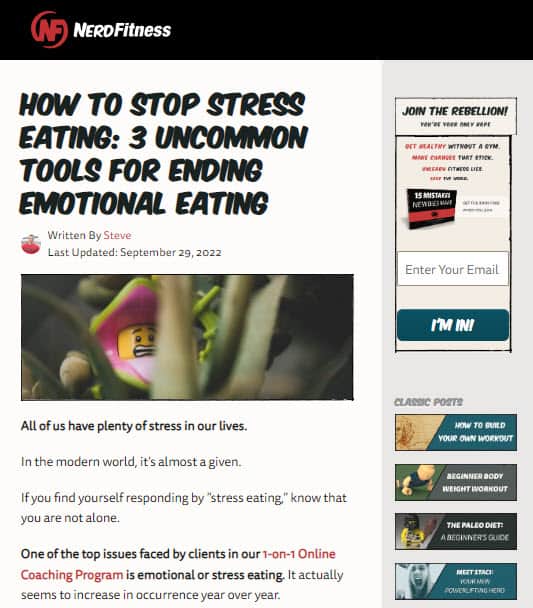
[auto-list-number] BetterSleep.org
This blog is focused on improving sleep quality and covers topics such as how to fall asleep faster, how to choose the right mattress, and how to get a good night’s rest.
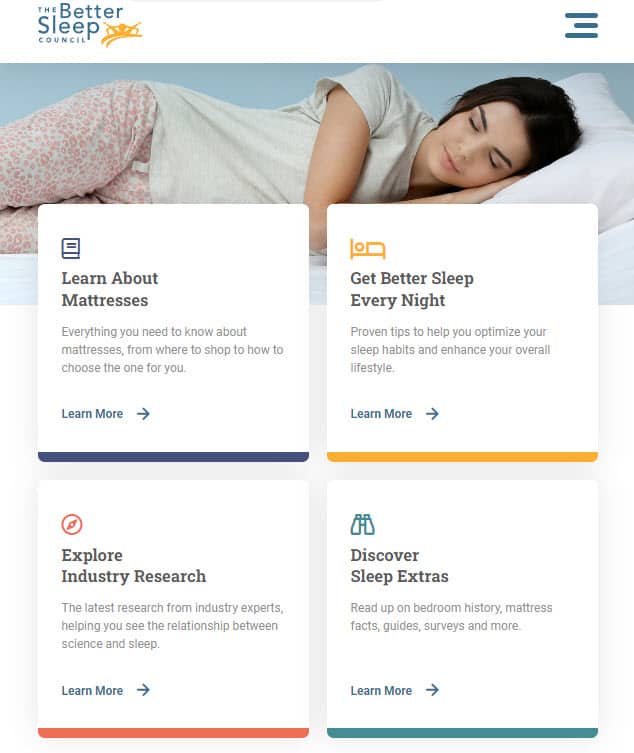
[auto-list-number] Mind Body Green
This is a general health and wellness blog that focuses on topics related to wellness, including nutrition, fitness, mental health, and more. If you want to start a blog like this, then create content in a particular niche. When you run out of topics, you can move to the next niche.

[auto-list-number] Mindfulness Exercises
This blog is focused on mindfulness and meditation. It covers topics such as how to meditate, the benefits of mindfulness, and how to live a more mindful life.

Avoid YMYL Niches
When you are thinking about what niche to choose for your health & wellness blog, avoid “Your Money or Your Life” (YMYL) niches.
These are niches where the advice you give could have a negative impact on someone’s life if they follow your advice and it doesn’t work out for them. Google has strict criteria for how safe it is to rank websites for these types of niches, and you may have a hard time getting search traffic in these niches even if your content is great.
To rank in these niches, you will need credentials like medical degrees. You need to show these credentials and often your content will need to be manually reviewed by someone in Google before it ranks for anything. Your articles need to be extremely well-researched and referenced. You need to cite scientific papers and journals. You also need to get a lot of links from several authority websites.
Some examples of YMYL niches in the health & wellness space include:
- nutrition advice
- weight loss supplements or programs
- mental illness medications or therapies
- how to manage chronic health conditions like diabetes or depression
You can check if your niche is YMYL by googling your keyword and looking at the top results. If the top search results are from websites like Health Line, WebMD, and MayoClinic then you will have a hard time ranking in these niches.
If you insist on choosing a YMYL niche, then try to choose a specific sub-niche that is not YMYL. For example, you will not be able to rank for information on the Keto diet because it is YMYL. But it will be much easier to rank for Keto Breakfast Recipes because it is not YMYL.
If you choose something YMYL make sure you demonstrate your experience and expertise. Cite credible sources and link to another website, peer-reviewed journals, and papers. Try to provide an expert angle or perspective on the topic you are writing about.
Make your choice wisely before you invest any effort.
3. Pick & Register a Blog Domain Name
Once you have chosen your niche, it is time to brainstorm a few names for your health & wellness blog.
We recommend you keep your health & wellness blog’s name to two words (Example: Nerd Fitness). One of the two words should be a keyword from your niche. The other word can be something that makes your website brandable. For example, our blog teaches people how to make passive income, so we have named it Passive Book.
Here are some of the words that you can mix and match into your blog name:
- Fitness
- Health
- Wellness
- Mindful
- Well
- Nutrition
- Eat
- Eating
- Shape
- Fit
- Nourish
- Sleep
- Heal
- Holistic
- Paleo
- Vegan
- Natural
- Bliss
Use a Business Name Generator to brainstorm the name of your blog.
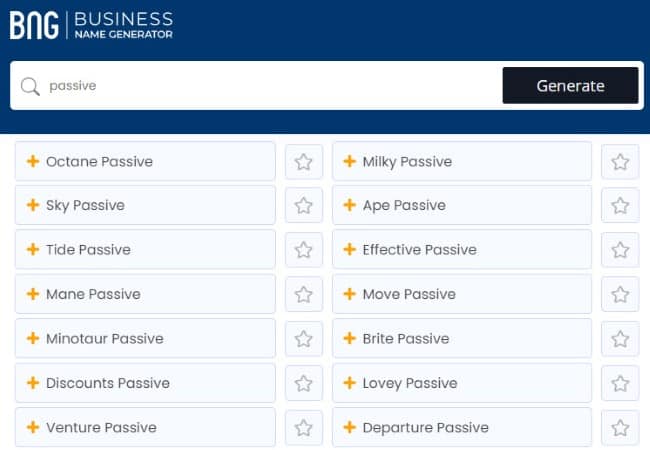
You can also use your own name for your blog. But if you ever plan to sell your website in the future, it is much more difficult to transfer your brand to the buyer when it is your name.
Check Domain Name Availability
After you have brainstormed a few names for your health & wellness blog, you should check if the .com domain name is available.
A domain name is the web address that people type into their browsers to visit your health & wellness blog. It is usually your health & wellness blog’s name followed by .com.
You must check if both the .com domain name and the social media handles are available. You can use Namechk to check the availability of both your domain name and social media handles.
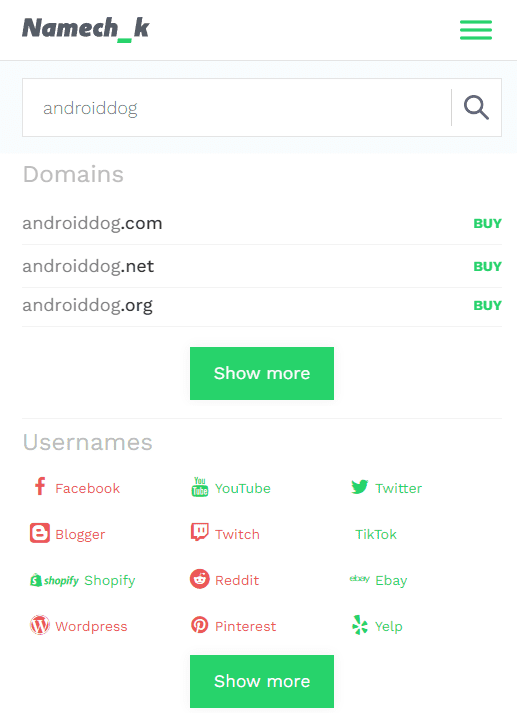
Here are a few things to keep in mind when selecting a domain name:
- Choose a .com domain name. 86% of the internet uses .com, so your visitors are likely to try visiting your blog by typing .com. Avoid other extensions like .net or .org.
- Don’t include hyphens and numbers.
- Do not use words with multiple spellings (for example colour vs color).
- Shorter domain names are better. Try to keep it under 12 characters.
- Spelling & Pronunciation should be easy and intuitive.
- It should be easy to remember.
- Avoid words that can be misread together. For example, therapistjohn.com can be read as Therapist John or The Rapist John.
- Make sure it’s not trademarked or copyrighted by someone else. The AI writing software Jarvis.ai had to rebrand to Jasper.ai because Marvel sued them for the Iron Man reference. Lawsuits will happen once your blog is established.
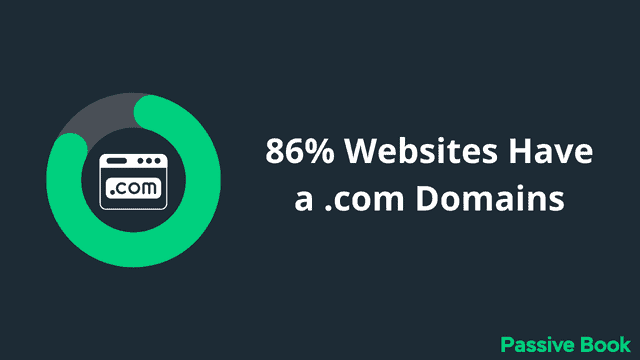
Register a Domain Name
Once you decide your domain name it is time to register it.
You should register your domain with NameCheap because you will get domain privacy for free. Other providers charge $12 per year for domain privacy. Without domain privacy, your name, home & email address will be accessible to the public.
Step 1: Go to NameCheap. Enter your domain name with the .com extension.
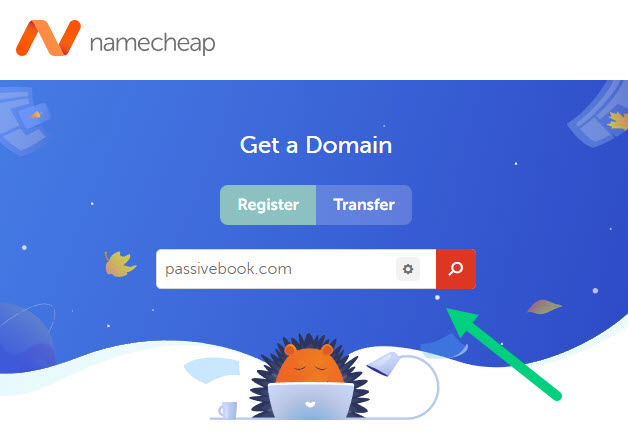
Step 2: Select the .com extension and click the Add to Cart button.
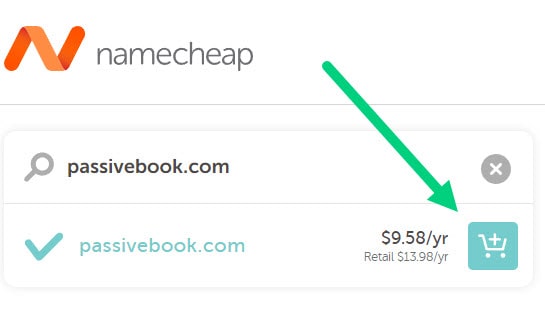
Step 3: After adding the domain to the cart, click on the Checkout button.
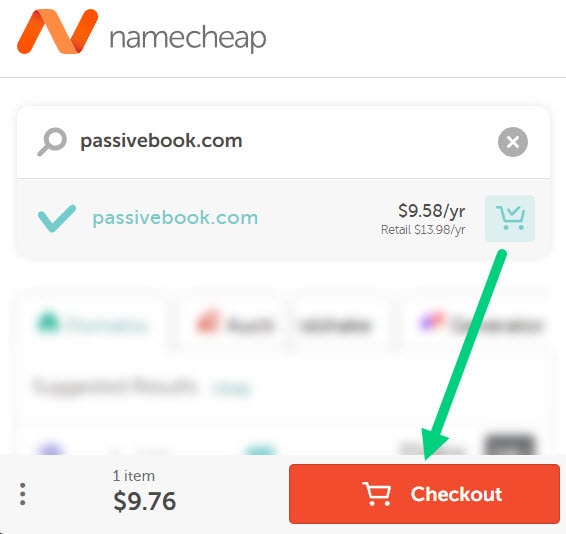
Step 4: Enable Domain Privacy that comes for free along with auto-renew. You don’t need any other paid addon.
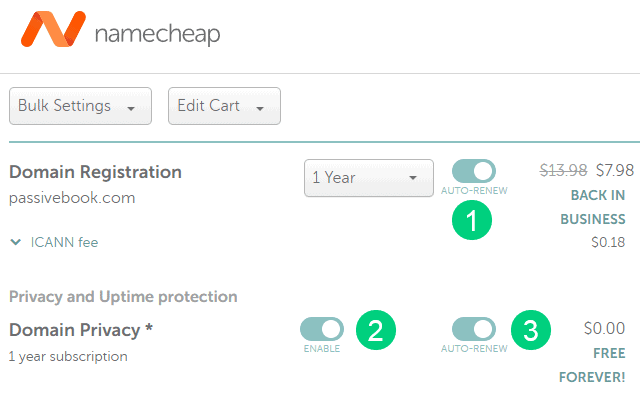
Step 5: Click on Confirm Order. Pay to complete your purchase.

Step 6: Log in to Namecheap and click on Domain List ❶ in the left sidebar and then click Manage ❷ next to the domain you just purchased.
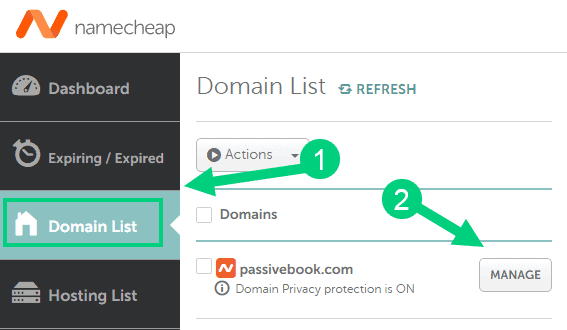
Step 7: Under the Nameservers section, select “Custom DNS” from the dropdown ❶. Then enter the following two nameservers ❷ ns1.bluehost.com and ns2.bluehost.com as shown in the image. Then click the green tick ❸ to save. If you use a hosting provider other than Bluehost, enter their nameserver values in this step instead.
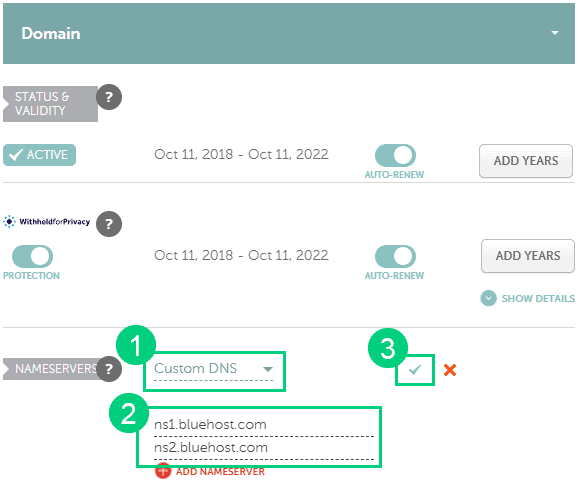
Can I get a free domain name?
Your web hosting provider might give you a free domain name for one year but they charge $12 for domain privacy which is free in Namecheap. From the second year, you will pay for both the domain and privacy which will cost you more than $20+. So it is cheaper to just register your domain with Namecheap from the beginning. Also using different companies for web hosting and domain registration will allow you to easily switch your blog host later without transferring domains.
Can I change the name of my blog later?
You will lose your search engine rankings if you change your blog’s name once it gets links from other websites. It will take as long as a year or more for you to regain the lost traffic. It is possible to mitigate problems by having proper redirects. But you will have to renew both your old and new domains every year. So try to avoid changing your blog’s name once it is established.
4. Setup WordPress
The next step is to get your blog up and running in WordPress.
WordPress is a content management system (CMS) that allows you to create a website or blog from scratch. WordPress is free and open source software released under the GPL.
Why Choose WordPress.org?
There are many blogging platforms but the self-hosted wordpress.org powers 70% of blogs on the internet. 42% of all websites on the internet use WordPress.

Some of the benefits of using WordPress.org include:
- A wide range of plugins and themes to customize how your site looks and works
- Enhanced security features to protect your blog from hackers and malware attacks
- Easy content management, allowing you to easily create, edit, and delete blog posts, pages, media files etc.
- Support forums and documentation to help you troubleshoot any issues or get your questions answered
WordPress.org vs WordPress.com
There are two versions of WordPress: WordPress.org and WordPress.com.
Many people make the mistake of choosing WordPress.com to build their blogs.
WordPress.org is the self-hosted version that you need to install on your own web hosting account, while WordPress.com is a hosted solution where web hosting is provided for you.
While WordPress.com is free, you cannot monetize your blog, or install plugins to enhance its features (unless you upgrade to their $45 paid plan). This makes it practically worthless.
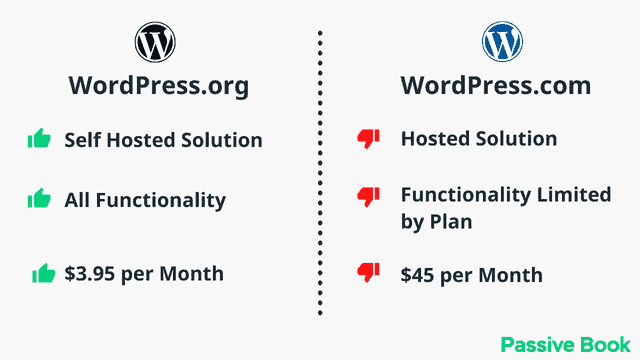
Self-hosted WordPress.org has none of these limitations. If you want to make money from your blog and have full customization control over your blog, the self-hosted version of WordPress.org is the best option.
Why Avoid Free Blogging Platforms
There are many free blogging platforms out there such as Blogger, Tumblr, Medium etc. While they may be tempting to use because they are free, it is not recommended for the following reasons:
- Your blog will not rank well in search engines. This is because these platforms are not optimized to rank in search engines.
- You will have limited control over how you can monetize your blog. But with a self-hosted WordPress site, you can sell ads, use affiliate links, create products etc.
- You will have limited customization options. This means you will not be able to fully optimize your blog for SEO and design it the way you want.
- You will not own your content. The platform can decide to delete your blog at any time without notice. This has happened to countless Blogger and Tumblr users.

For all these reasons we recommend using self-hosted WordPress.
How much does it cost to create a health & wellness blog?
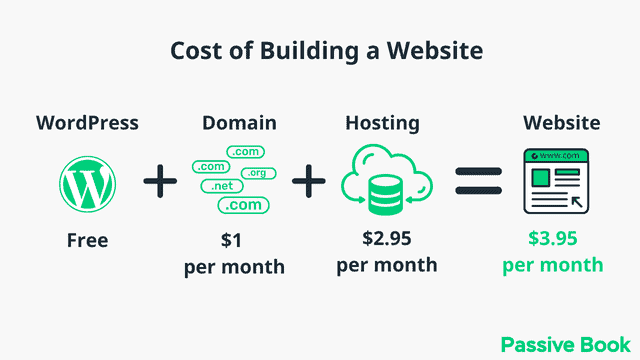
It will cost you $2.95 per month to host your WordPress health & wellness blog in Bluehost. A domain will cost you $12/year. So that is a total of $4.2 per month, which is less than the price of Netflix for all the unlimited features that a self-hosted WordPress blog has to offer.
What to do if you already have a free blog?
If you’re currently using a different blogging platform, such as Blogger or Tumblr, it’s very easy to migrate your content over to WordPress. There are import plugins available that will do all the work for you.
Install WordPress in Hosting
WordPress is free to install and use but you will need hosting to install WordPress.
Blog hosting is the service that provides storage and bandwidth for your blog. This is where you will upload your blog files, including your WordPress installation. When someone visits your blog, your hosting provider will transfer your blog posts and images into the visitor’s browser enabling them to access it.
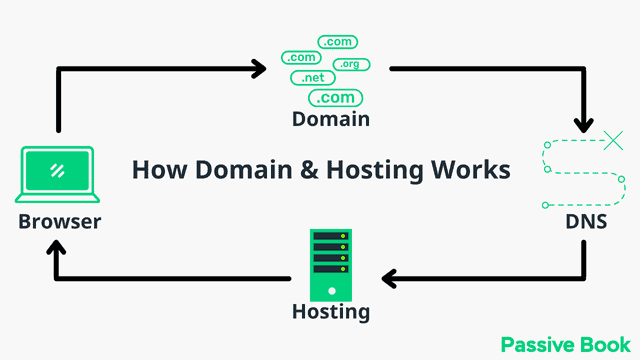
For this guide, we will use BlueHost as our web host. It is a cheap hosting that is extremely easy for beginners to set up. If you use any other web host, the steps will be the same but the user interface may be slightly different.
1. Go to BlueHost using this link to get a special discount. Select WordPress > WordPress Hosting from the top menu.
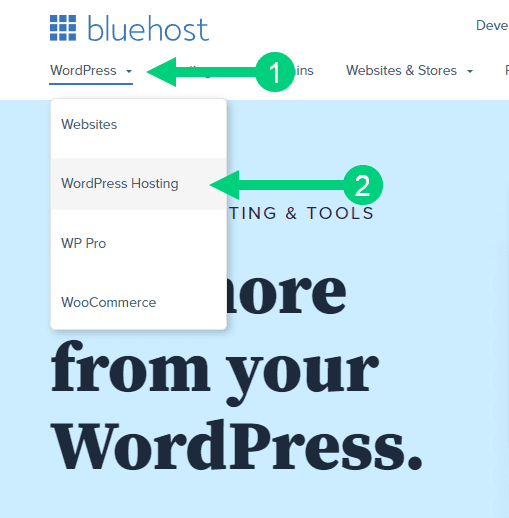
2. Click on the button you see on this page and you will be taken to the pricing section.
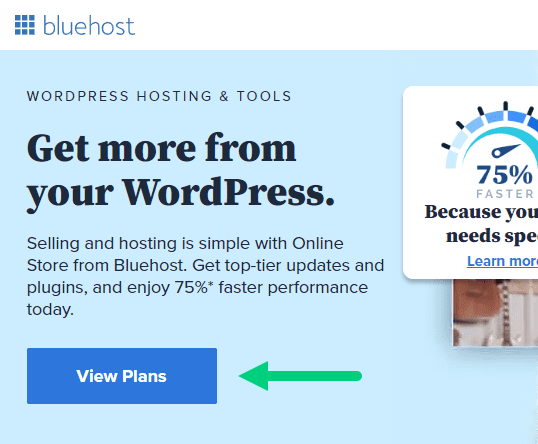
3. Select the Basic Plan. You can upgrade to a different hosting plan as you grow.

4. If you already have a domain name that you purchased with Namecheap you can put that in the “Use a domain you own” ❶ section. If you don’t have a domain name yet, choose the “Create a New Domain” ❷ to purchase a new domain.
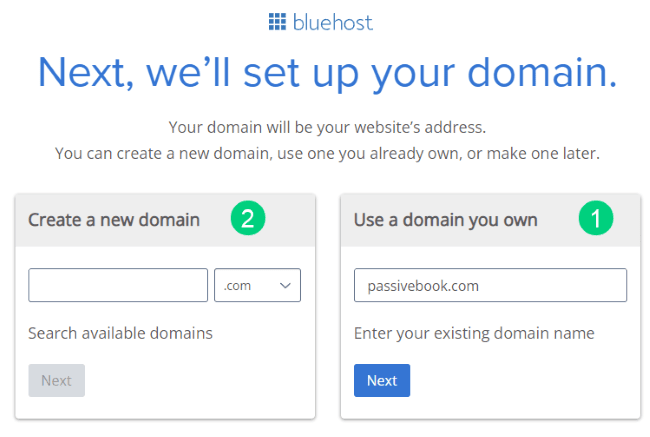
5. In the next screen, enter your information. Uncheck all package extras. If you purchase your domain through Bluehost instead of Namecheap, you may want to enable Domain Privacy. You won’t see the Domain Privacy option if you bought your domain through Namecheap. Namecheap will give you this Domain Privacy for free.
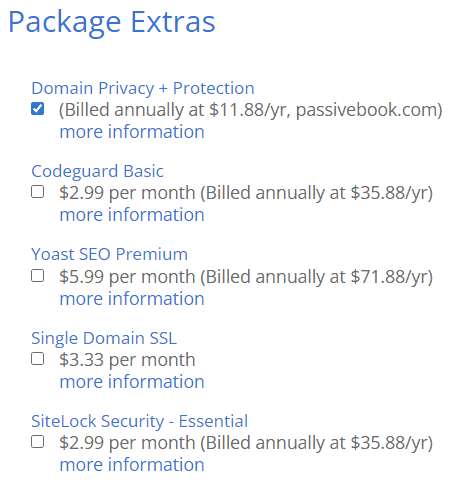
6. Once you have successfully paid, you will be prompted to set a password. Click on the “Create your Password” button.
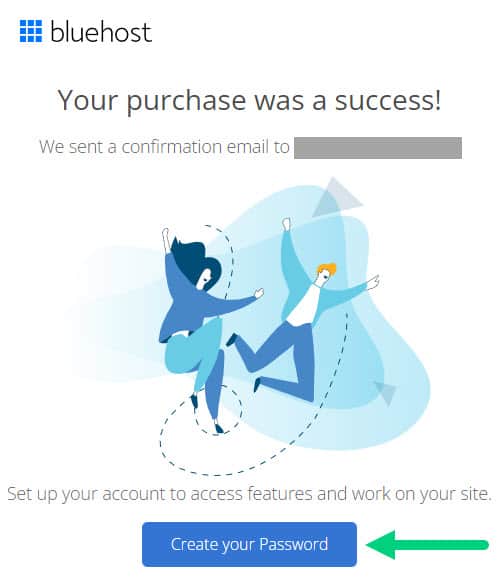
7. Enter your password and create your account. If you lose this password, you can reset it.
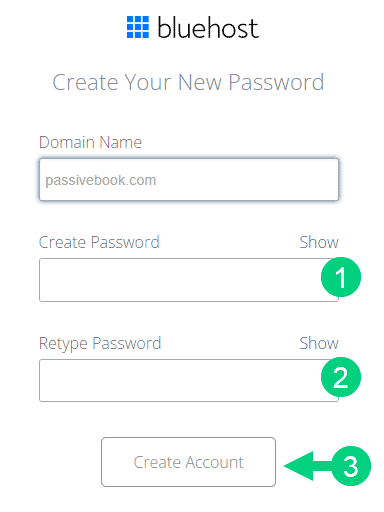
8. After you set your password, log in to Bluehost.
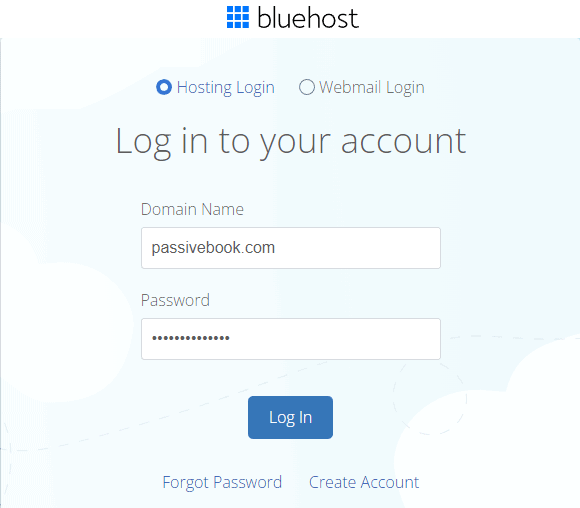
9. Click on the Create your website button on the following screen. This will start a Bluehost Wizard, just click Skip this step wherever possible.

10. On the following page, click “No help needed” or “Skip this step”. We don’t want Bluehost to limit our customization options.
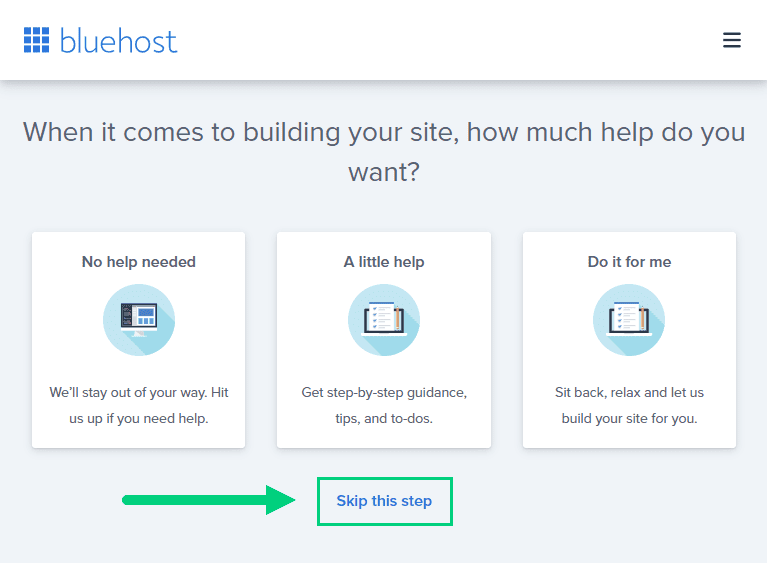
11. On the next page, you will be asked about the purpose of your website. You can choose from any of the available options.
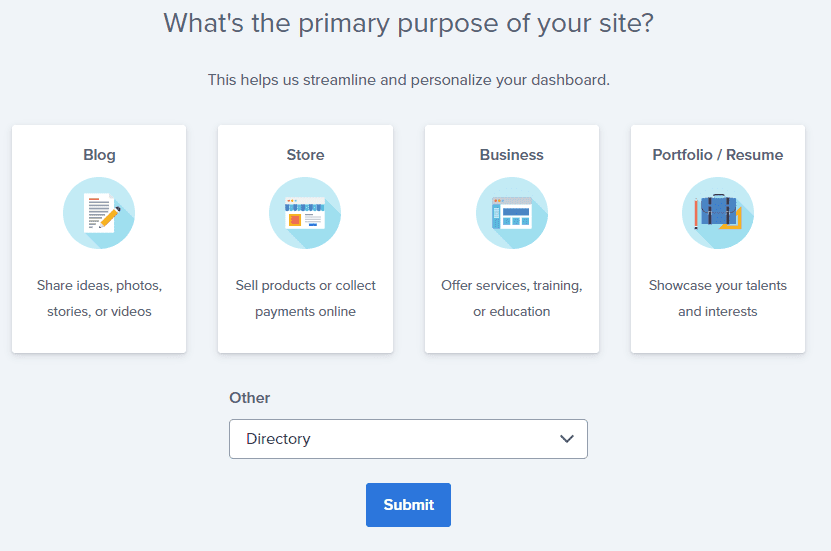
12. On the next page, click Skip this step.
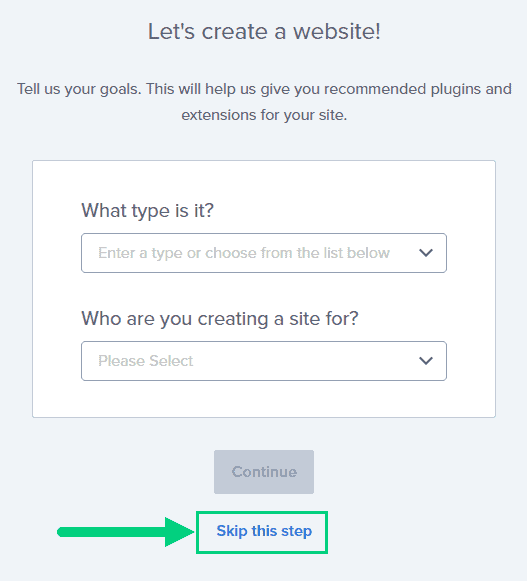
13. On the following page, enter the blog’s name and tagline. You can change this later so feel free to click “Skip this step” or enter something as a placeholder and click Continue.
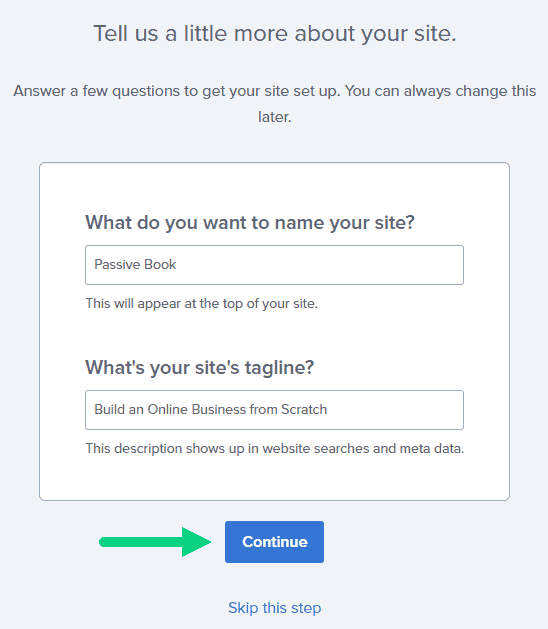
14. Finally you will be asked how you want to build your website. Choose “Limitless customization” to have all the options.

15. You can see your blog by going to yourdomain.com. Go to the Bluehost dashboard and click on the My Sites tab ❶ in the left sidebar and click on the “Manage site” button ❷.
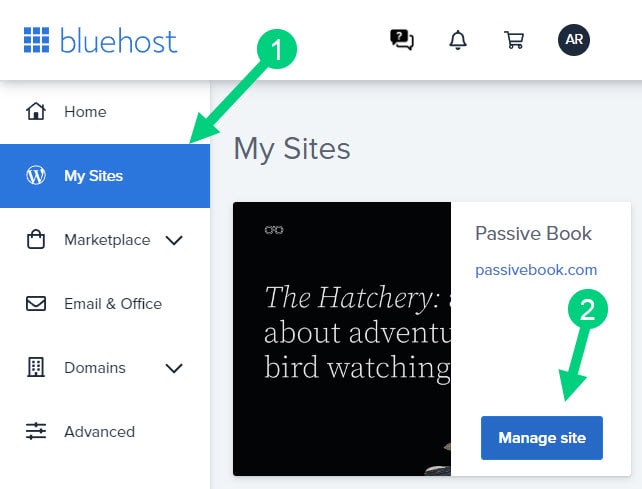
16. Your WordPress site has separate login credentials different from the ones you use to log into Bluehost. You can use this to log in to the WordPress dashboard directly without logging into Bluehost. To get this:
❶ Click on Users on top.
❷ You will be able to see your username and email that you can use to log in to WordPress.
❸ If you click on the three dots you will see the option to Reset your password. ❹
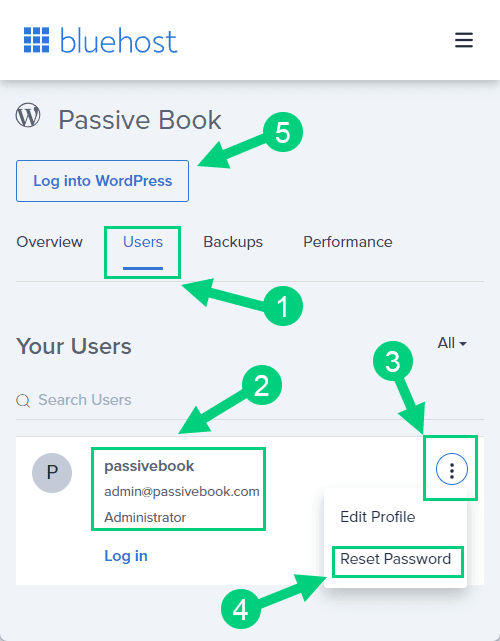
You can log into WordPress from the Bluehost dashboard by clicking the Log in to WordPress button ❺. But it is not recommended you rely on this as your primary login method because you will get locked out of your site if you ever change hosting providers.
17. You will be taken to the WordPress dashboard where you can reset your password ❶. If you don’t like the username Bluehost created for you, you can Add a New User ❷.

18. If you are adding a new user make sure you specify the user role as Administrator ❶. You can log in as the new user and safely delete the default user created by Bluehost.
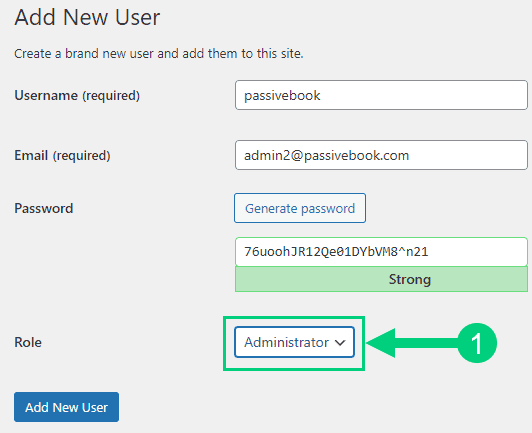
Congratulations! You have successfully set up WordPress.
Configure WordPress
Now that you have the basic version of WordPress installed, it is time to customize it to make it look and feel the way you want.
Login to WordPress Dashboard
The WordPress Dashboard is the central location from which you control all aspects of your WordPress site. From here you can create new posts and pages, change your site settings, add plugins and themes, and much more.
Visit yourdomain.com/wp-admin to access the WordPress dashboard.
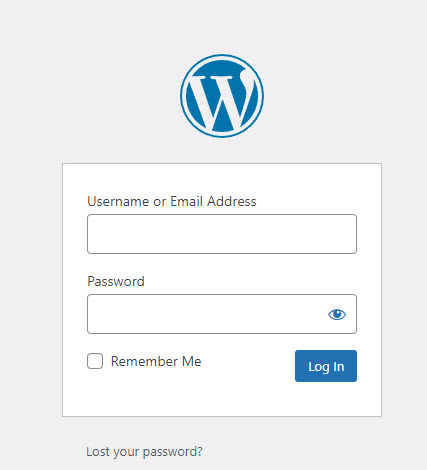
Use the Email and Password you provided during installation to log in to your WordPress dashboard. If you don’t have a password, use the “Lost your password?” to generate a new password.
Install WP Themes
A WordPress theme is a collection of files that determine the look and feel of your WordPress site. It includes the HTML, CSS, and JavaScript files that control the layout and design of your site.
When you install a WordPress theme, it will change the entire look and feel of your site. This is a great way to quickly and easily customize your site to make it look exactly how you want.
Your new WordPress blog will be installed with a default blog theme that doesn’t look very great.
To install a new WordPress Theme:
Go to Appearance > Themes > Add New in your WordPress dashboard.
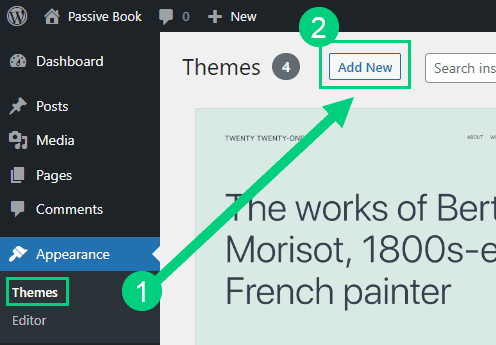
Use the search to find a theme that you like ❶. Before you install the theme, you can see a demo of the theme and learn about its features from the preview screen ❷. If you like the theme, you can install it by clicking the install button ❸. You can also upload a theme from a file on your computer ❹.
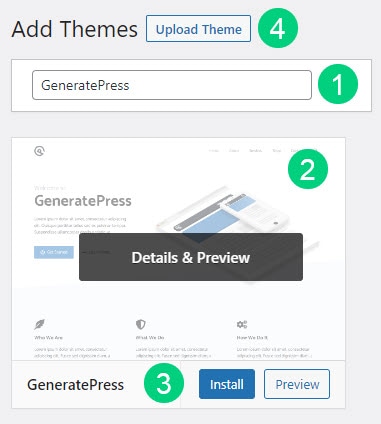
Once installed, click the Activate button to enable the theme.
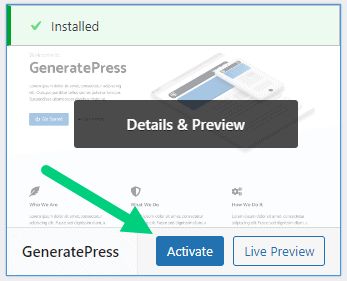
Although you can use a free theme (there are thousands of free themes available), we recommend using a premium theme.
Premium themes not only reduce your website’s load time but also help you customize your website to your heart’s desire.
Here are the premium themes we recommend:
There are also several custom-made health & wellness blog themes. These themes tend to be bloated with poor code which will slow down the performance of your website. We suggest getting one of our recommended themes for a fast website with unlimited customization possibilities.
Install WP Plugins
A WordPress plugin is a software that adds additional features and functionality to WordPress. There are over 50,000 WordPress plugins available for free from the WordPress Plugin Directory.
Plugins can add all sorts of features to your WordPress site, such as social media integration, contact forms, photo galleries, and more.
Too many wordpress plugins can slow down your blog site. So before you install new plugins, it will be worth clearing out any existing plugins that your hosting provider installed by default.
Plugins first need to be deactivated before they can be deleted.
❶ Go to WP Admin > Plugins > Installed Plugins
❷ Click on the checkbox to select all plugins.
❸ Select Deactivate from the drop-down.
❹ Click Apply.
❺ Repeat the above steps but select “Delete” instead of “Deactivate” from the dropdown in ❸ to delete all the deactivated plugins.
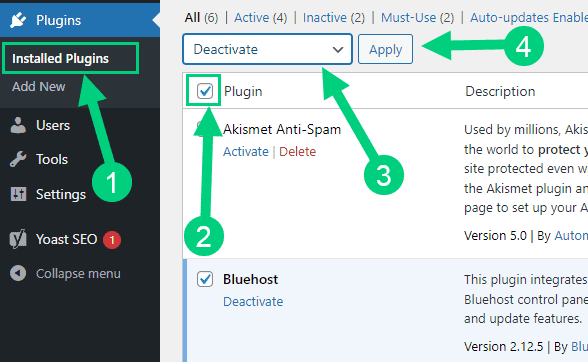
To install new plugins go to the WP Admin > Plugins > Add New.
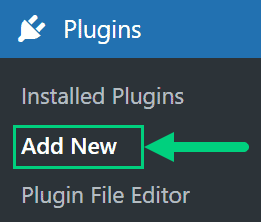
On the plugins page:
❶ Search for the plugin you want in the search bar
❷ Click Install Now. Once you install the plugin, you must also activate the plugin for it to be enabled.
❸ If you are installing a paid plugin you can upload the plugin instead.
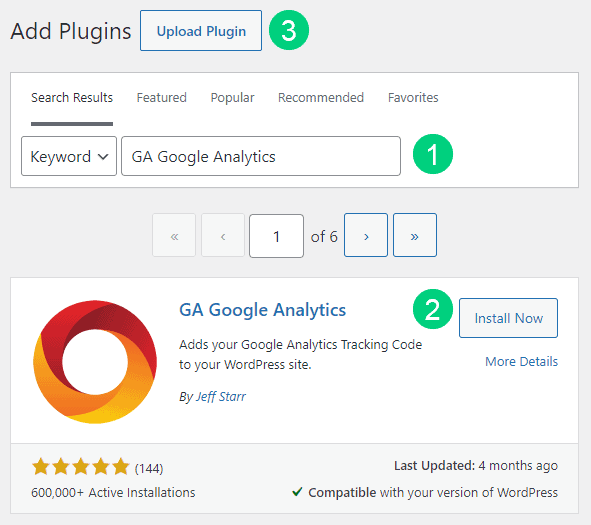
There are many different health & wellness blog plugins that you can install, but here are the ones which we recommend:
Backup Plugin
A WordPress Backup Plugin helps you create backups of your WordPress site. This is a great way to protect your website from accidental deletion or data loss. Backup plugins can also help you migrate your website to a new host or server.
Recommended Plugin: WPVivid (paid) or UpdraftPlus (free).
SEO Plugin
A WordPress SEO plugin helps optimize your website for search engines. It can help you improve your website’s visibility in search engines, increase your website’s click-through rate (CTR), and improve your website’s overall search engine ranking.
Recommended Plugin: RankMath (paid).
Google Analytics Plugin
A WordPress Google Analytics Plugin helps you track your website’s traffic and visitor behavior. It can help you see how many people are visiting your website, where they are coming from, and how they are interacting with your website.
Recommended Plugin: RankMath (paid) or GA Google Analytics (free).
Cache Plugin
A WordPress Cache Plugin speeds up your website by caching your website’s data. The plugin will store a copy of your website’s data on the server so that it doesn’t have to be regenerated every time someone visits your website.
Recommended Plugin: WP Rocket (paid).
Page Builder Plugin
A WordPress Page Builder Plugin helps you create custom pages and posts for your website. It allows you to easily add and edit content on your website, without having to know how to code.
Recommended Plugin: Thrive Architect (paid).
Security Plugin
A WordPress Security Plugin helps you protect your WordPress website from hackers and malware. It can help you secure your website’s files, passwords, and user accounts.
Recommended Plugin: Wordfence (free).
Social Media Plugin
A WordPress Social Share Plugin lets your readers share your website’s content on social media. It adds social media buttons for Facebook, Twitter, LinkedIn, and other social media platforms.
Recommended Plugin: Easy Social Share Buttons (paid).
Email List & Lead Generation Plugin
A WordPress Email Opt-in Form Plugin helps you collect email addresses from your website’s visitors. It allows you to easily add a form to your website that will allow visitors to subscribe to your email list.
Recommended Plugin: Thrive Leads (paid).
Customize WordPress
Once you have installed your theme and plugins, it is time to customize the wordpress blog platform:
Change Colors, Fonts & Spacing
You can set the font, colors, and spacing by going to Appearance > Customize in your WordPress dashboard. Premium themes like GeneratePress allow you to customize every aspect of your blog.

Check out our Blog Fonts & Typography guide to choose the right font and typography settings for your blog.
Add Your Logo
Get a logo designed for your blog from Fiverr. Then set the logo of your blog by going to Appearance > Customize in your WordPress dashboard. A logo is not required for a successful blog but it can definitely help appeal to your target audience.
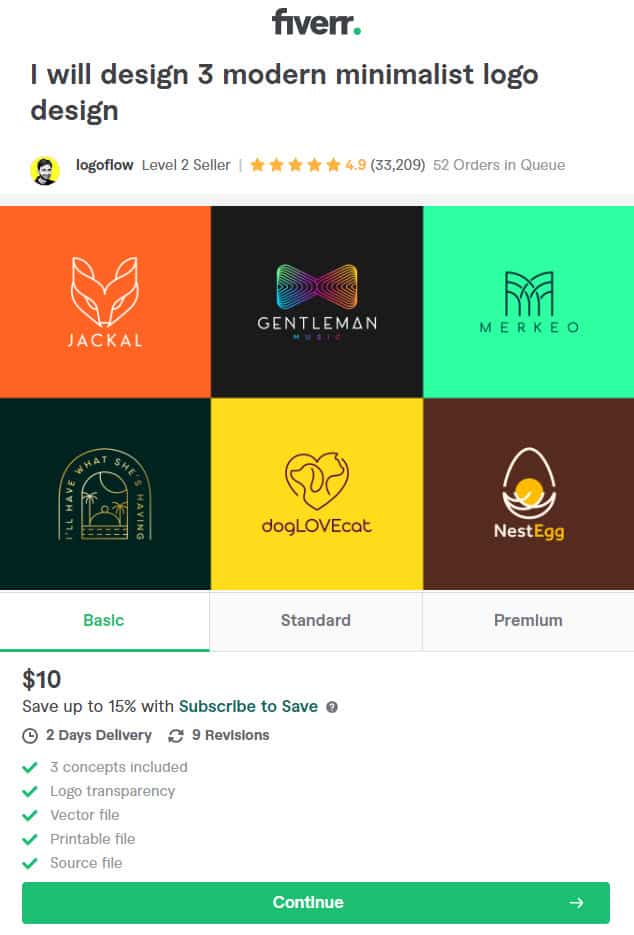
Change Favicon
Favicon is the image that appears in the browser tab and bookmarks. Set the Favicon from the Appearance > Customize section of the WordPress dashboard.

Create Menus
The header and the footer menu can be set from the Appearance > Menus in your WordPress blog dashboard.
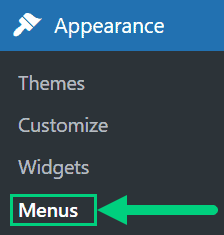
You can nest menu items so that it appears as a dropdown menu ❶. You can use the menu as your primary or secondary navigation menu ❷. Don’t forget to save your menu ❸.
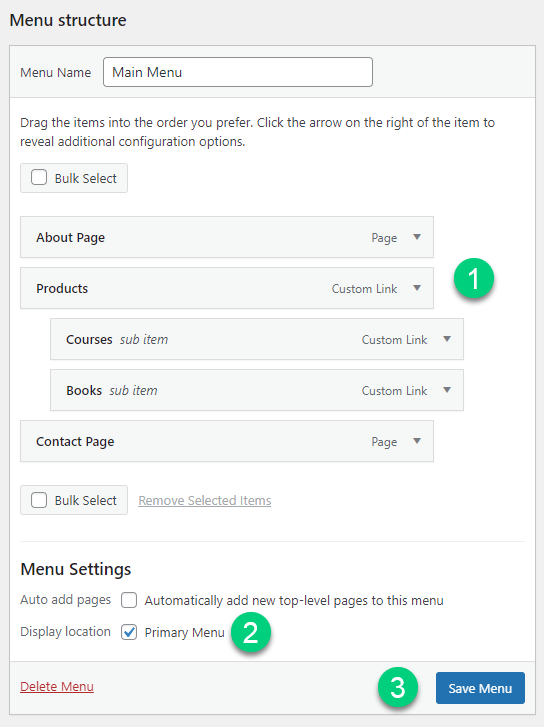
Create Widgets
If you have a sidebar, you can add widgets to it. Go to Appearance > Widgets in your WordPress admin dashboard.
Check out the list of the most useful Blog Widgets and how to add them to your blog.

Set Title & Tag Line
The next step is to change your General Settings. Go to Settings > General in the WordPress Admin area.
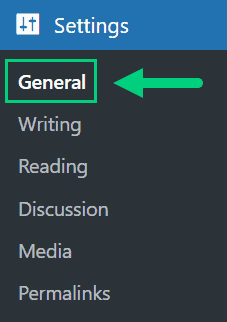
You can set your Site Title, Tagline, and Time Zone from this screen.
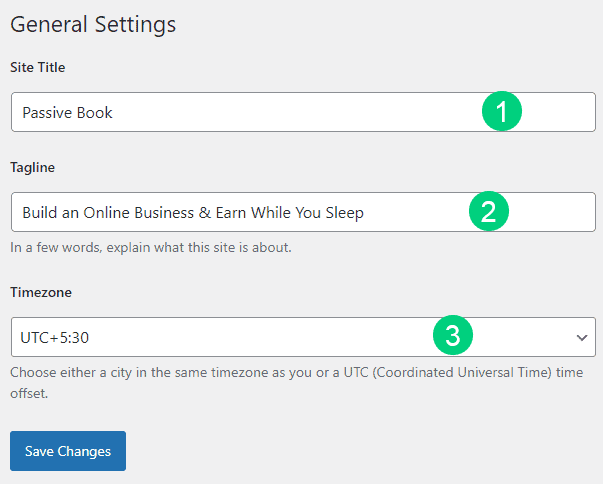
Set Permalinks
The ideal URL structure for SEO is yourdomain.com/sample-post. Set your permalink structure by going to Settings > Permalinks in your WordPress blog dashboard.

Select the “Post name” radio button and save changes.
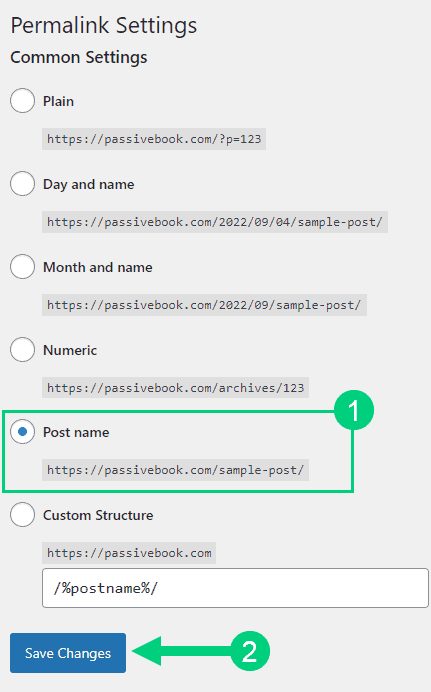
Enable Search Visibility
Chances are you want your blog to show up on Google so people can find you. Go to Settings > Reading in your WordPress dashboard.
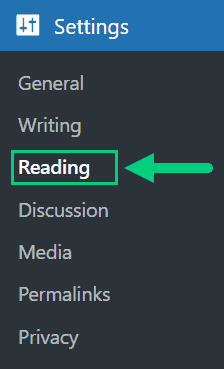
To get search engine traffic, ensure the checkbox “Disable search engines from indexing this site” is Unchecked. You can find this option in Settings > Reading. Most of the time this should be unchecked by default but if it is not, then uncheck it to ensure your site gets traffic from search engines.
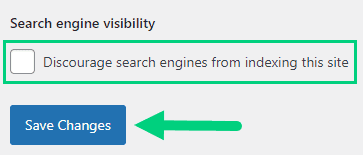
Adjust Comment Settings
Next, you will want to change the Discussion Setting (aka Comments). Go to Settings > Discussion in your WordPress admin area.
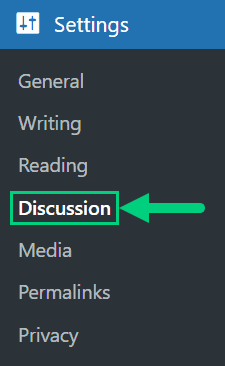
❶ You may want to enable or disable comments on this page. You can also disable pingbacks and enable comment moderation.
❷ You can also set comment approval settings.
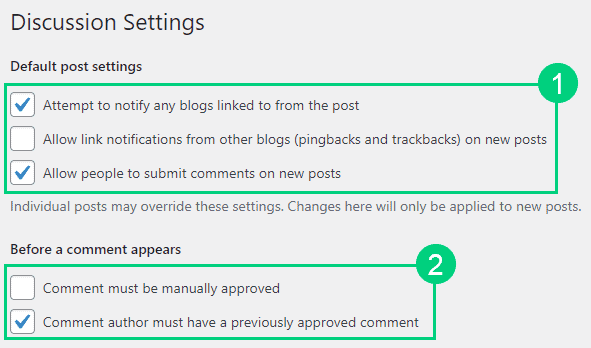
If you want to design your blog further, check out our dedicated guide on blog design which has all our best blog design recommendations.
Create Static Pages
There are a few essential pages that you need to create for your health & wellness blog before you can start blogging.
Use pages in WordPress to add static content. Go to WP Dashboard > Pages > Add New.
- Write the headline of your content.
- Populate the body content
- Click the publish button.
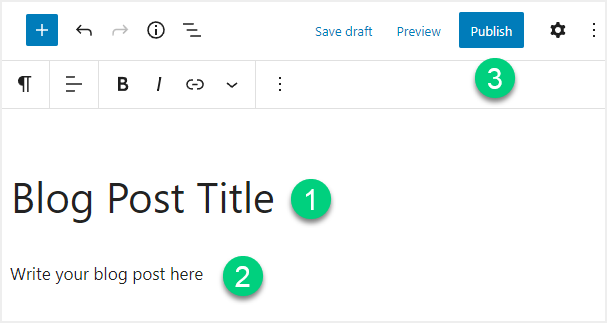
You may want to create the following pages:
Home Page
A home page is the main page of your website. It is the first page that your visitors see when they visit your website. The home page usually contains a Welcome message, a brief description of your website, and a list of your website’s most recent blog posts.
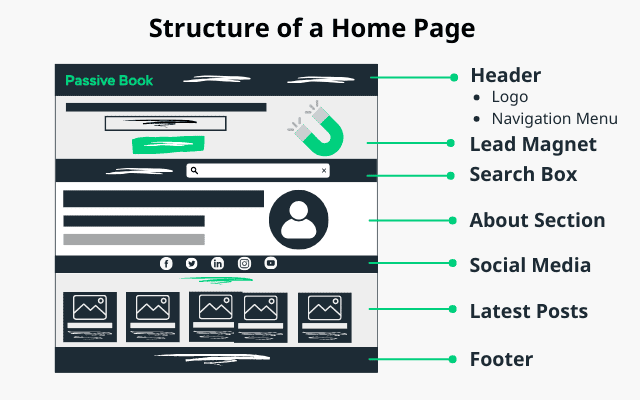
You can create a professional home page for your health & wellness blog using a page builder like Thrive Architect.
About Page
An About page is the “About” section of your website. It typically includes a brief description of your blog and how it came to be, as well as information about yourself, such as your blogging goals and how you got into blogging in the first place.
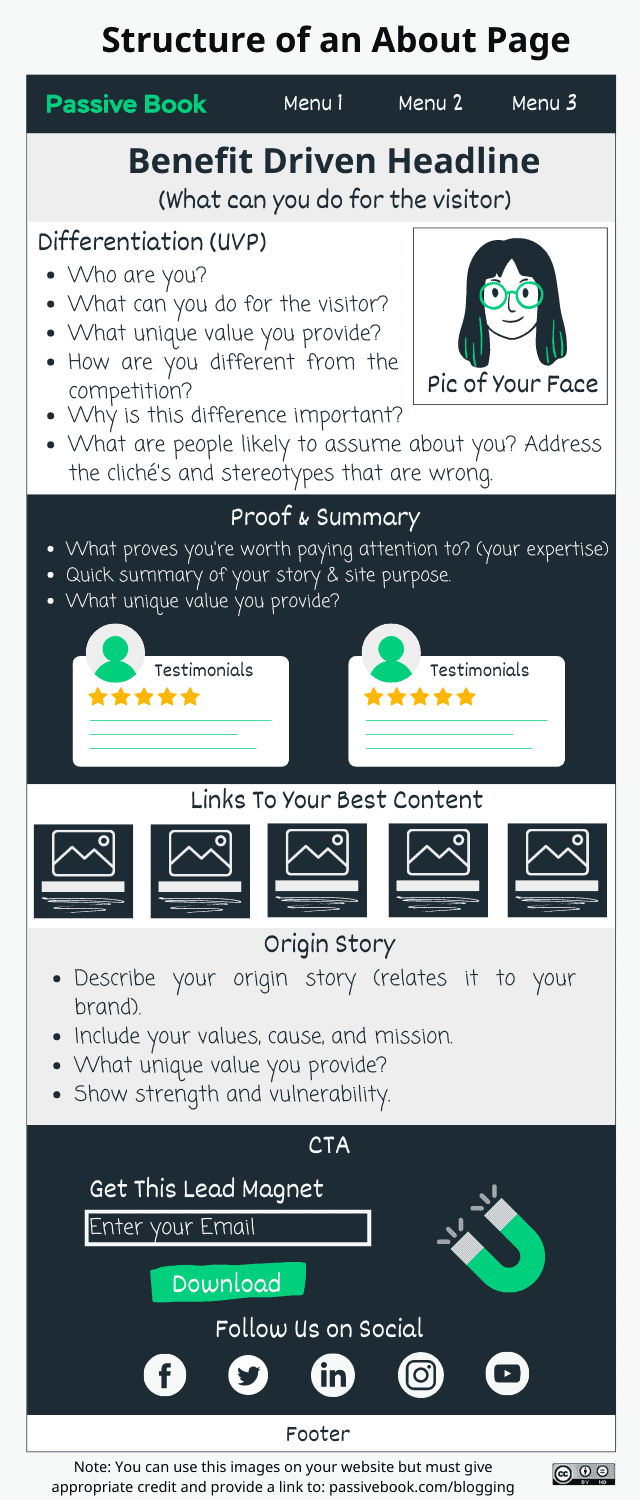
Contact Page
A contact page is the “Contact” section of your website. It includes your contact information, such as your email address, social media handles, and a form that visitors can use to contact you.
Use contact form plugins like Fluent Forms to create the form on your contact page.
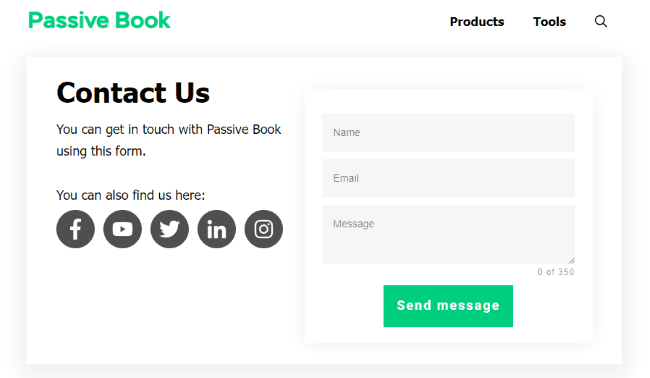
Privacy Policy
A privacy policy is a legal document that discloses how you collect, use, and store your website’s visitors’ information. It is required by law if you collect any personal information from your website’s visitors.
WordPress generates its own privacy policy for you. But you can also use a tool like Termly to generate your own privacy policy.
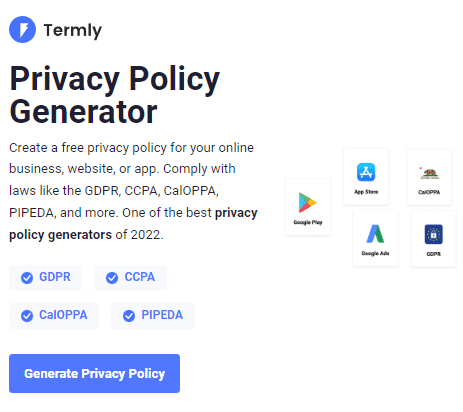
Terms of Service
A terms of service is a legal document that sets forth the rules and regulations that govern your website. It is required by law if you have a website that allows users to sign up for an account, post comments, or buy products or services.
Use a terms & conditions generator like Termly to create it.
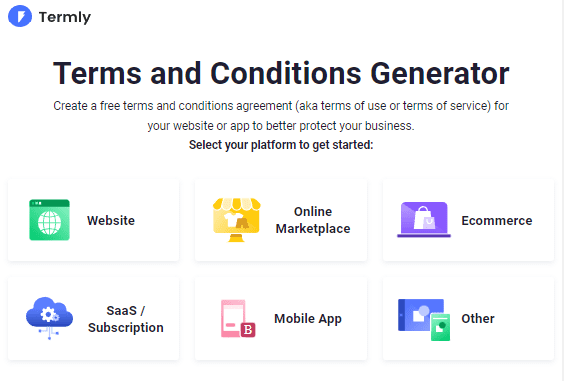
5. Write & Publish Blog Posts
Now that you have your health & wellness blog set up, it’s time to write and publish your first blog post. To craft the perfect blog post, check out our in-depth guide on How to Write A Blog Post. Here we will go over specific tips for a health & wellness blog.
1. Brainstorm Topics
You should brainstorm 100 topic ideas for your health & wellness blog. This will ensure that you always have content to write about in your health & wellness blog.
The goal is to find topics for your health & wellness blog that your audience is searching for in Google. The type of content you write on your health & wellness blog will depend on your specific niche.
Here are a few health & wellness blog post ideas, you can potentially cover in your health & wellness blog:
- How-To Guide
- List Posts
- Question Posts
- Product Reviews
- Case Studies
There are a few ways to brainstorm specific content:
Look at Competitors
If you want to be a successful health & wellness blogger, you need to be constantly creating new content. But how do you come up with topic ideas?
One way is to look at other health and wellness blogs and see what type of content they are writing about. This can give you some great ideas for your own blog.
But don’t just copy their content. You want to create your own unique spin on the topic.
To find your competitor’s blog posts, do a Google search for your main keyword and scroll through the top search results.
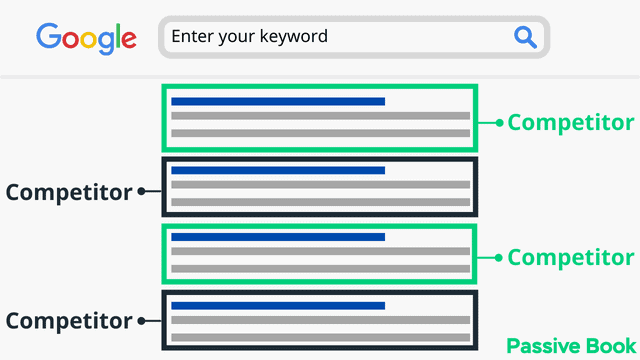
Do Keyword Research
To do keyword research, you can use a tool like Keywordtool.io. This tool will help you find keywords that your audience is searching for in Google.
To use the tool, simply type in a keyword and hit the search button. It will then generate a list of similar keywords.
When you write articles targeting these keywords, you will help people looking for this information find your blog.
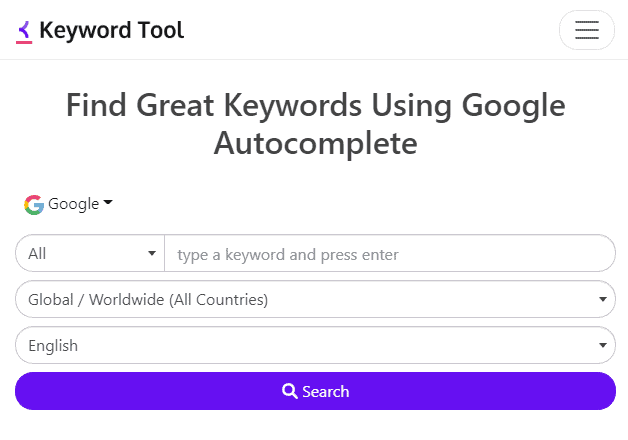
Community & Forums
One way to find blog post topics is to look for communities and forums that are related to your niche. This can be a great way to find topic ideas that your audience is interested in.
To find communities and forums, do a Google search for “[your niche] community” or “[your niche] forum”. For example, if you are in the health & wellness niche, you could search for “health & wellness community” or “health & wellness forum”.
2. Create an Editorial Calendar
Once you have a list of ideas for your health and wellbeing blog, it’s time to start creating an editorial calendar. This will help you plan out your health articles in advance and ensure that you are consistently publishing content.
An editorial calendar is a planning tool that helps you organize your content ideas and ensure that you are publishing content consistently.
The benefits of using an editorial calendar are:
- It Helps You Stay Organized
- It Helps You Plan Ahead
- It Helps You Stay on Track
Your editorial calendar will help you plan out how much content you need to publish each month, and how often you need to publish it.
An editorial calendar should include the following:
- Post Titles
- Post Topics
- Publication Dates
- Authors
- Category
Download Content Calendar Template

Steal our exclusive content calendar template. Have it delivered directly to your inbox:
To create an editorial calendar for your health & wellness blog, use a spreadsheet or calendar tool like Google Calendar to track your content ideas.
3. Write a Blog Post
Once you have your editorial calendar set up, it’s time to start writing your blog posts.
How-To Posts
One of the most popular types of content in health & wellness blogs is how-to posts. This post will the people who read your blog improve their health step-by-step.
How-to posts explain how to do something related to your niche and provide actionable advice for your audience. They are easy for a reader to follow along with and digest, which is one of the reasons why how-to content is so popular.
Here are a few examples of How-To posts:
- How to eat mindfully
- How to make time for workouts
- How to disinfect your screens
- How to start meal planning
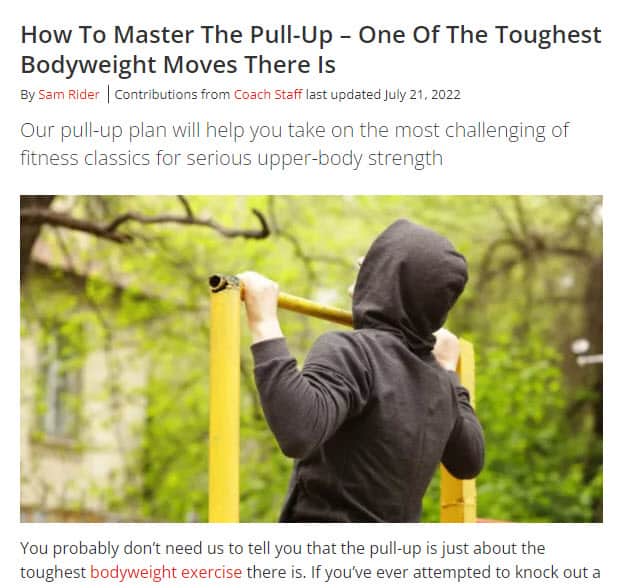
To write a how-to post for your health & wellness blog, start by brainstorming how you could help your readers solve a problem or achieve a goal in their life. Then, break down each step that someone would need to take to complete the task or goal on their own.
Make sure that you are using clear language and examples wherever possible. And don’t be afraid to include images and photos in your how-to posts, as this can make the content even easier to follow along with.
List Posts
Another popular type of blog article in the health & wellness niche is list posts. It is usually a list of things for better health.
List posts are exactly what they sound like — they’re articles that include a list of items, tips, or resources related to your niche.
List posts are popular because they are easy for readers to scan and digest. And if you can come up with an interesting or unique list, it can be a great way to capture attention and stand out from other bloggers in your niche.
Here are a few examples of list posts:
- The ultimate list of vegan-friendly restaurants
- 5 easy ways to get more protein in your diet
- 10 habits of happy and successful people

Brainstorm a list of items, tips, or resources that would be helpful or interesting for your audience. Once you have your list, start writing a brief description for each item on the list.
When writing list posts, make sure to use clear and concise language so that readers can easily scan the content. Have the most interesting item on your list as the first item and the most obvious item on your list as the last item. And if possible, try to come up with an interesting or unique angle for your list to make it more likely to capture attention.
Question Posts
Question posts are articles that answer a specific question related to your niche. They are similar to how-to posts in that they provide actionable advice, but they focus on answering a specific question instead of teaching someone how to do something.
Here are a few examples of question posts:
- How often should I workout?
- Is it better to diet or exercise?
- What are the best foods to eat for breakfast?
- How fast can I lose weight?
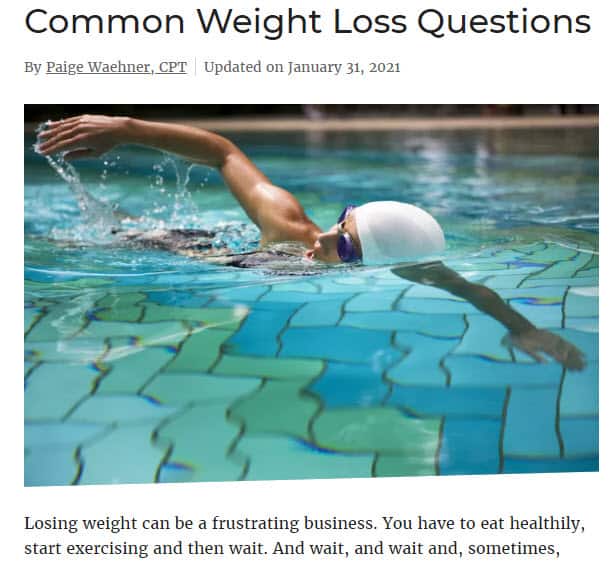
Start by brainstorming questions that your audience might have about your niche. Once you have a few questions, choose the one that you think would be most interesting or helpful for your readers to know the answer to.
Then, do some research and put together an answer to the question that is clear and actionable. Make sure to back up any claims you make with evidence from reputable sources.
You should immediately answer the question in the first few paragraphs immediately after the introduction. Then you can expand on your answer in the rest of your article and include nuances in your answer. If you can, try to include a personal story or example in your question post to make it more relatable for your readers.
Product Reviews
Another type of post that can be popular in the health & wellness niche is product reviews.
Product reviews are articles that provide detailed information and analysis about a specific product related to your niche.
While product reviews might seem like they can only be used for ecommerce or physical products, there’s no reason why you couldn’t review digital products as well, like apps, ebooks, or online courses.
Here are a few examples of product reviews:
- The best fitness trackers for 2021
- The ultimate guide to the best yoga mats
- A comprehensive review of the top 5 healthy eating cookbooks
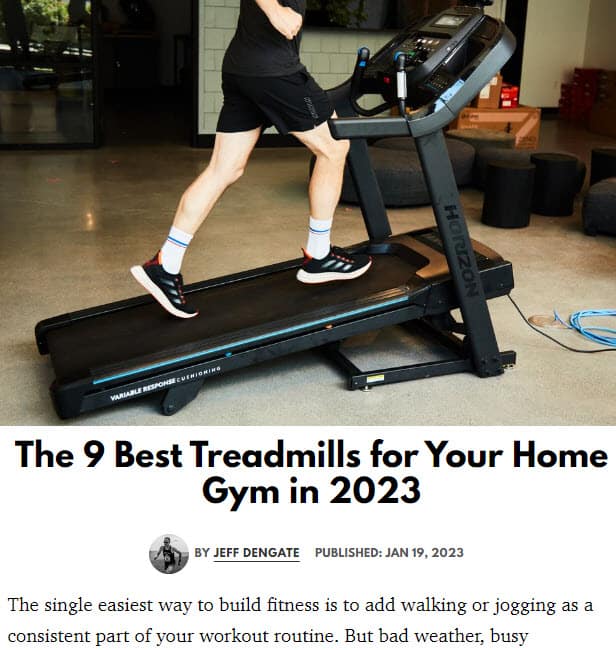
Start by brainstorming products that would be relevant and interesting for your audience. Once you have a list of potential products, narrow it down to 1-3 products that you want to focus on.
Then, do some research on each product and put together a detailed analysis. Make sure to include both the pros and cons of each product so that your readers can make an informed decision.
If you can, try to use the product yourself before writing the review so that you can provide first-hand experience. And be sure to include plenty of images and videos in your review to break up the text and make it more visually appealing.
Case Studies
Another type of post that can be popular in the health & wellness niche is case studies.
Case studies are articles that provide detailed information and analysis about a specific case or situation related to your niche. They are similar to how-to posts and question posts in that they provide actionable advice, but they focus on a specific case instead of teaching someone how to do something or answering a specific question.
Here are a few examples of case studies:
- How I lost 50 pounds in 6 months
- My experience with intermittent fasting
- How I quit smoking after 20 years
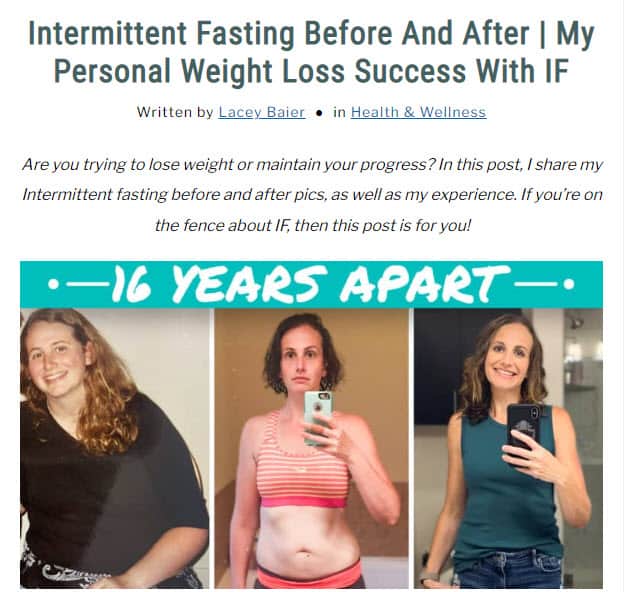
To write a case study for your health & wellness blog, start by brainstorming cases or situations that would be relevant and interesting for your audience. Once you have a list of potential cases, narrow it down to 1-3 cases that you want to focus on.
Next, do some research into the case and put together a detailed analysis. Make sure to include both the strengths and weaknesses of each case so that your readers can draw interesting conclusions from your study.
Include plenty of data in your case study and try to use real examples or quotes from people who have been through the same situation as your readers. And be sure to include at least one image or infographic in your case study for visual appeal.
Write 5x Faster With AI
You can write your new blog post at 5x speed using the AI writing software Jasper. I was able to write over a hundred blog articles in 3 months using Jasper. This blog article you are reading right now was written with the help of Jasper. AI will not only help you write blog posts fast but also with higher quality.
Jasper can write plagiarism-free blog content, articles, social media content, emails, and ad copy. All you have to do is provide a few inputs on what you want and Jasper will do all the hard work of creating the blog content for you. No more writer’s block.
Check out the video below to see Jasper in action:
Try Jasper for free using the links on this page and get 10,000 bonus credits you can use to start writing your first articles.
Once you sign up for Jasper I recommend you spend some time going through the tutorial videos in the Jasper Bootcamp to truly unlock the power of this amazing software.
Check out our guide on How to Write a Blog Post Fast in 15 mins Without Losing Quality for more tips to write fast.
Outsource Writing
If you’re looking for high-quality content but don’t have the time or resources to write it yourself, you can always outsource your writing to freelancers.
You can find freelancers on freelance marketplaces like Upwork and Fiverr.

If you decide to outsource your writing, make sure that you give clear instructions on what type of content you want and how long it should be. Also, be sure to provide detailed guidelines on the style and tone of voice that you want your blog posts to have. And remember to keep an eye on the turnaround time so that you can review and approve the content on time.
Several content writing agencies specialize in creating well-written and researched articles for health & wellness blogs. And because they work with a variety of clients, they often have a good understanding of what type of content performs well in the health & wellness niche.
When selecting a content writing agency, be sure to look at their past work to get an idea of their writing style and quality. You should also make sure that they offer a satisfaction guarantee so that you can get your money back if you’re not happy with the final article.
Regardless of how you choose to create your health & wellness blog posts, it’s important to make sure that they are well-written, researched, and visually appealing.
4. Add Images
One of the factors that makes a blog post successful is how engaging it is. This is why adding images and videos to your blog posts can be a great way to increase engagement and improve how well your content ranks in search engines.
The best photos are the ones you take yourself. This is because you have complete control over the composition, lighting, and editing of the photo. Your image will also be unique to your blog. You can get started by taking photos with your smartphone camera.
If you cannot take your own photos, you can use stock images. There are many websites where you can find high-quality stock photos:
Free Options: Pixabay, Pexels, Upsplash
Paid Options: Deposit Photos, Shutterstock, iStock, Getty Images, 123rf.
When adding images to your blog posts, make sure you optimize them for the web. This means using the correct file format (PNG or JPEG), compressing your images so that they have a small file size that won’t slow down your website load time, and using keywords in your image file name and alt text so that it shows up in search results.
If you want to add images to your blog posts but don’t have any experience editing them, you can use Canva. It is a free online graphic design tool that makes it easy to create professional-looking images with its drag-and-drop interface.
If you want high-quality images to use in your blog posts, without paying for expensive stock photography websites, you should consider upgrading to Canva Pro. It gives you access to a library of over 1 million stock images, as well as a range of other features that can help you create better-looking images.
6. Promote Your Health & Wellness Blog
One of the most important parts of starting a successful health & wellness blog is promoting your content so that people can actually find and read it.
There are several ways you can promote your blog posts, including:
Search Engine Optimization (SEO)
SEO is the process of optimizing your blog posts so that they rank higher in search engine results pages (SERPs). This means that more people will organically find your content through search engines.
There are many things you can do to optimize your blog posts for SEO, including:
- using keywords throughout your blog post
- optimizing your title and meta tags
- creating internal links
Many factors go into SEO, and it can be a bit confusing to figure out where to start. You can master the more advanced SEO tactics by checking out our SEO Resources.
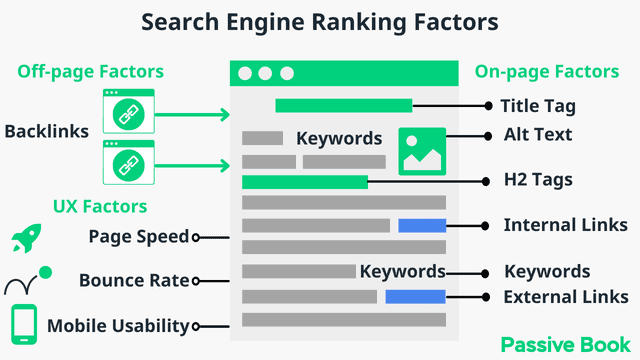
You can ensure you get the basics of SEO right, by completing the recommendations given by the RankMath plugin.
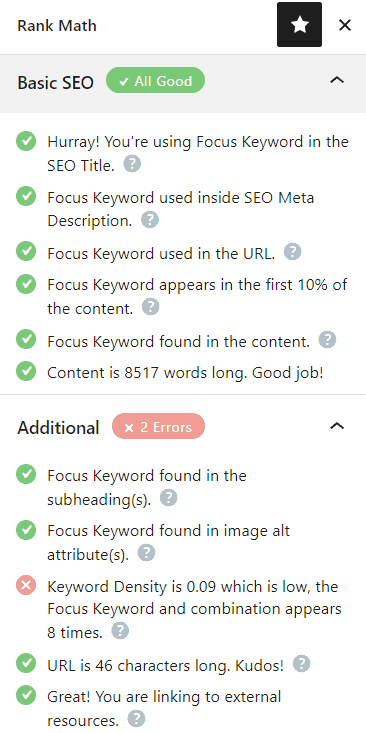
Email Marketing
Another great way to promote your health & wellness blog is through email marketing. This involves sending emails to people who have signed up to receive updates from you.
Email marketing can be a great way to build relationships with your readers and promote your blog content. It’s also a great way to drive traffic to your website and generate leads for your business.

You can use the Thrive Leads plugin to build opt-in forms to collect email addresses. You can then connect the opt-in form to an email marketing service like Active Campaign to send out the emails.
Check out our Email Marketing resources to learn more.
Social Media Marketing
Another powerful way to promote your health & wellness blog is through social media marketing.
Social media platforms, like Facebook and Twitter, are a great way for you to connect with your target audience and build brand awareness.
To get started with social media marketing, you’ll first want to create social profiles that accurately represent the voice of your brand. You’ll also want to create shareable content that your target audience will want to read, watch, or listen to.
Once you have a strong social media presence, you can start promoting your blog content on your social channels. Make sure you post regularly and use engaging visuals, like images and videos, to capture the attention of your followers.
Guest blogging
Another great way to promote your blog is through guest blogging. Guest blogging involves writing content for blogs other than your own. By creating high-quality content on other websites, you can increase the visibility and reach of your health & wellness blog.
To get started with guest blogging, you’ll need to identify blogs that are relevant to your industry and niche. Once you’ve found a few guest blogging opportunities, reach out to the blog owners and offer to write a guest post for their website.
When writing your guest post, make sure you include a link back to your website. This will help drive traffic back to your site and increase the visibility of your blog. You can also promote and link back to your blog from your author bio.

7. Monetize & Make Money
One of the main goals of starting a health & wellness blog is to generate income for your business. There are many different ways that you can monetize your blog and make money from it:
Advertising
One of the most common ways to monetize a blog is through advertising. You can work with brands and businesses to place ads on your website. These ads can be in the form of banner ads, text links, or product reviews.
To get started with advertising, you’ll need to sign up for an ad network. Once you are approved they will give you a code to place on your blog to show ads. You will get paid depending on the number of views and clicks you have on your blog.
To start advertising on your blog, you can sign up for an ad network like Ezoic (they pay more than Google Adsense). When your blog starts getting more than 100,000 page views a month you can monetize with Adthrive.
| Ad Network | Earnings Per 1K Impressions (EPM) | Monthly Traffic Requirement |
|---|---|---|
| Ad Thrive | $13 | 100,000 |
| Ezoic | $3 | 10,000 |
| Media.net | $1 | – |
| Google Adsense | $1 | – |
Affiliate Marketing
Another great way to monetize your blog is through affiliate marketing. Affiliate marketing involves promoting products or services and earning a commission for each sale that you generate. You can include your affiliate links in product reviews.
To get started with affiliate marketing, you’ll need to sign up for an affiliate program. Once you are approved, you will be given an affiliate link to promote the product or service on your blog. When a reader clicks on your affiliate link and makes a purchase, you will earn a commission.
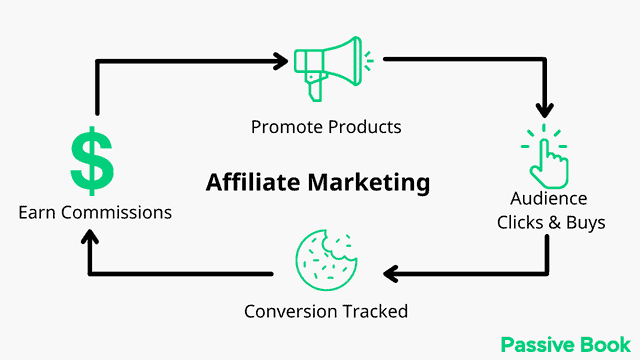
You can sign up for an affiliate program like Amazon Associates to get started with affiliate marketing on your health & wellness blog.
Digital Products
You can also monetize your health & wellness blog by selling digital products. Digital products can include ebooks and online courses.
To get started with selling digital products, you’ll need to create the product first. Once it is ready, you will need to set up a sales page for your product on your website.
You can use Teachable if you want to sell video courses. Your students will have a dedicated course members area and a community system to ask questions and interact with each other. If you only want to sell eBooks, you can use SendOwl which lets you sell your digital products and eBooks for free.
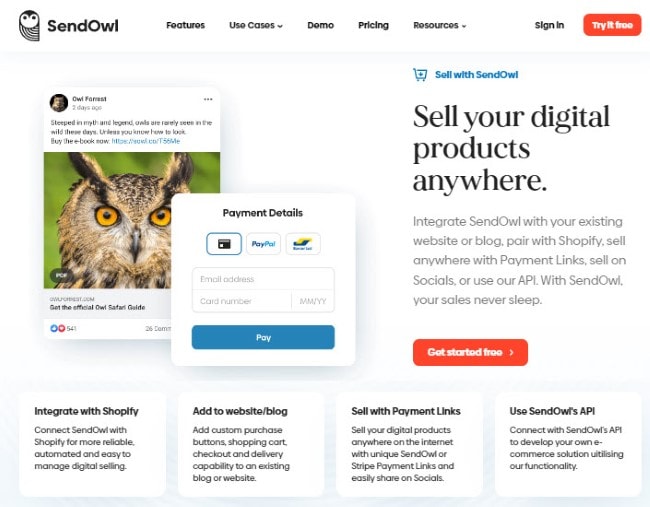
Sell Services
Another great way to monetize your blog is by selling services. If you have a career in health like a doctor, health coach, dietician, or nutritionist you can use your blog to build a personal brand and sell your services on your blog. For example, if you are a health & wellness coach, you can sell your coaching services on your blog.

To get started with selling services on your blog, you’ll need to create a service page that outlines the services you offer and how much they cost. Once you have your service page set up, you can start promoting it on your blog and social media channels.
Physical Products
Finally, you can also monetize your blog by selling physical products. If you make and sell health & wellness products you can promote and sell them on your blog.
Some of the products you can sell can include:
- Herbal teas
- Health supplements
- Fitness equipment
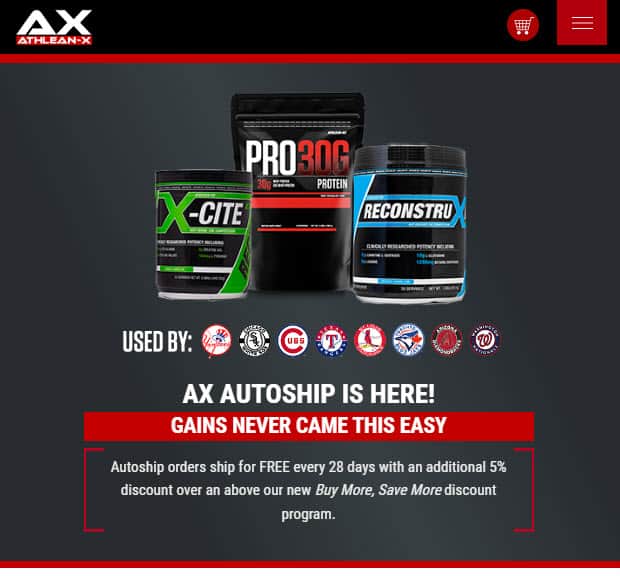
To get started with selling physical products on your blog, you’ll need to set up a shop page on your website. You can do this using Woocommerce or Shopify.
Sponsored Posts
Another great way to monetize your blog is through sponsored posts. Sponsored posts are articles that are written by you and paid for by a brand or business.

To get started with sponsored posts, you’ll need to identify companies or brands that would be interested in sponsoring your blog. Once you’ve found a few potential sponsors, reach out to them to see if they are interested in working with you.
FAQ
Is a health blog profitable?
Health blogs can be profitable if you monetize them in the right way. There are many different ways to monetize a health blog, including advertising, affiliate marketing, selling digital products, and sponsored posts.
How often should I post on my health blog?
How often you post on your health blog will depend on how much time you have to dedicate to blogging, as well as how quickly you want to grow your audience. If you can commit to posting 3-5 times per week, that is a good starting frequency. You can always adjust your posting schedule down the line if needed.
What Next?
Starting a health & wellness blog can be a great way to share your passion for healthy living with the world and potentially make some money in the process.
We hope this guide showed you how to start a health & wellness blog.
If you have any questions as you set up your new blog, leave a comment below so we can help you out.
Have you started your health & wellness blog yet? What type of health & wellness blog are you going to start? Let us know in the comments.
Share this post with your friends & followers:
